Related Research Articles
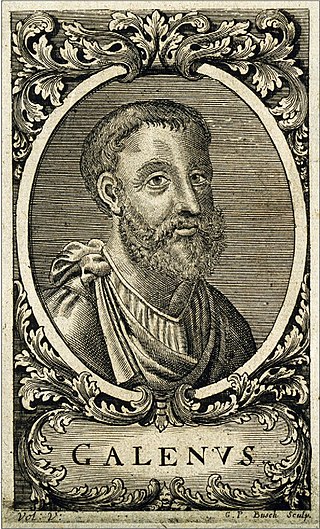
Aelius Galenus or Claudius Galenus, often anglicized as Galen or Galen of Pergamon, was a Roman and Greek physician, surgeon, and philosopher. Considered to be one of the most accomplished of all medical researchers of antiquity, Galen influenced the development of various scientific disciplines, including anatomy, physiology, pathology, pharmacology, and neurology, as well as philosophy and logic.
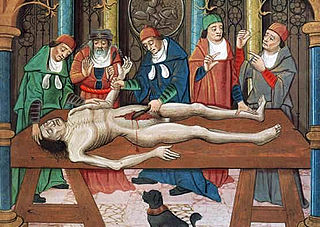
The history of anatomy extends from the earliest examinations of sacrificial victims to the sophisticated analyses of the body performed by modern anatomists and scientists. Written descriptions of human organs and parts can be traced back thousands of years to ancient Egyptian papyri, where attention to the body was necessitated by their highly elaborate burial practices.

Embryology is the branch of animal biology that studies the prenatal development of gametes, fertilization, and development of embryos and fetuses. Additionally, embryology encompasses the study of congenital disorders that occur before birth, known as teratology.
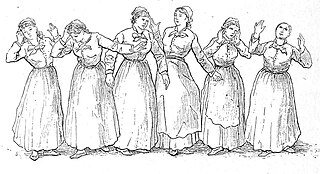
Hysteria is a term used to mean ungovernable emotional excess and can refer to a temporary state of mind or emotion. In the nineteenth century, female hysteria was considered a diagnosable physical illness in women. It is assumed that the basis for diagnosis operated under the belief that women are predisposed to mental and behavioral conditions; an interpretation of sex-related differences in stress responses. In the twentieth century, it shifted to being considered a mental illness. Many influential people such as Sigmund Freud and Jean-Martin Charcot dedicated research to hysteria patients.

Aretaeus is one of the most celebrated of the ancient Greek physicians. Little is known of his life. He presumably was a native or at least a citizen of Cappadocia, a Roman province in Asia Minor, and most likely lived in the second half of the second century AD. He is generally styled "the Cappadocian" (Καππάδοξ).

In the history of medicine, "Islamic medicine" Also known as "Arabian medicine" is the science of medicine developed in the Middle East, and usually written in Arabic, the lingua franca of Islamic civilization.
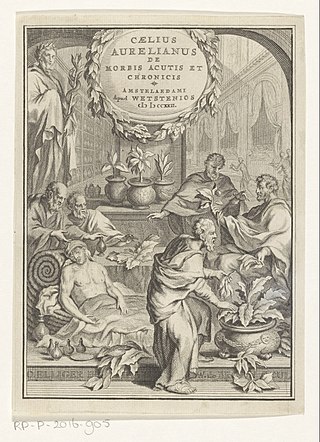
Caelius Aurelianus of Sicca in Numidia was a Greco-Roman physician and writer on medical topics. He is best known for his translation from Greek to Latin of a work by Soranus of Ephesus, On Acute and Chronic Diseases. He probably flourished in the 5th century, although some place him two or even three centuries earlier. In favour of the later date is the nature of his Latin, which shows a strong tendency to the Romance, and the similarity of his language to that of Cassius Felix, also an African medical writer, who about 450 wrote a short treatise, chiefly based on Galen.

Female hysteria was once a common medical diagnosis for women. It was described as exhibiting a wide array of symptoms, including anxiety, shortness of breath, fainting, nervousness, sexual desire, insomnia, fluid retention, heaviness in the abdomen, irritability, loss of appetite for food or sex, even sexually forward behavior, and a "tendency to cause trouble for others". It is no longer recognized by medical authorities as a medical disorder. Its diagnosis and treatment were routine for hundreds of years in Western Europe.
Sander L. Gilman, born on February 21, 1944, is an American cultural and literary historian. He is known for his contributions to Jewish studies and the history of medicine. He is the author or editor of over ninety books.
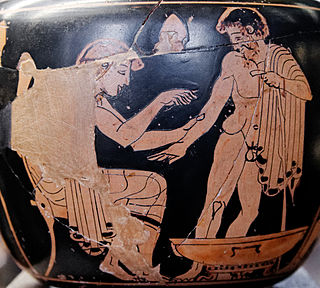
Ancient Greek medicine was a compilation of theories and practices that were constantly expanding through new ideologies and trials. The Greek term for medicine was iatrikē. Many components were considered in ancient Greek medicine, intertwining the spiritual with the physical. Specifically, the ancient Greeks believed health was affected by the humors, geographic location, social class, diet, trauma, beliefs, and mindset. Early on the ancient Greeks believed that illnesses were "divine punishments" and that healing was a "gift from the Gods". As trials continued wherein theories were tested against symptoms and results, the pure spiritual beliefs regarding "punishments" and "gifts" were replaced with a foundation based in the physical, i.e., cause and effect.

Medicine in ancient Rome was highly influenced by ancient Greek medicine, but also developed new practices through knowledge of the Hippocratic Corpus combined with use of the treatment of diet, regimen, along with surgical procedures. This was most notably seen through the works of two of the prominent Greek physicians, Dioscorides and Galen, who practiced medicine and recorded their discoveries. This is contrary to two other physicians like Soranus of Ephesus and Asclepiades of Bithynia, who practiced medicine both in outside territories and in ancient Roman territory, subsequently. Dioscorides was a Roman army physician, Soranus was a representative for the Methodic school of medicine, Galen performed public demonstrations, and Asclepiades was a leading Roman physician. These four physicians all had knowledge of medicine, ailments, and treatments that were healing, long lasting and influential to human history.
The one-sex and two-sex theories are two models of human anatomy or fetal development discussed in Thomas Laqueur's book Making Sex: Body and Gender from the Greeks to Freud. Laqueur theorizes that a fundamental change in attitudes toward human sexual anatomy occurred in Europe in the 18th and 19th centuries. He draws from scholars such as Aristotle and Galen to argue that prior to the eighteenth century, women and men were viewed as two different forms of one essential sex: that is, women were seen to possess the same fundamental reproductive structure as men, the only difference being that female genitalia was inside the body, not outside of it. Anatomists saw the vagina as an interior penis, the labia as foreskin, the uterus as scrotum, and the ovaries as testicles. Laqueur uses the theory of interconvertible bodily fluids as evidence for the one-sex model. However, he claims that around the 18th century, the dominant view became that of two sexes directly opposite to each other. In his view, the departure from a one-sex model is largely because of political shifts which challenged the way women's sexuality came to be seen. One result of this was the emerging view of the female orgasm as nonessential to conception after the eighteenth century. Women and men began to be seen as opposites and each sex was compared in relation to the other. Freud's work further perpetuated the sexual socialization of women by dictating how they should feel pleasure.
Alexander Philalethes was an ancient Greek physician, whom Priscian called Alexander Amator Veri, and who was probably the same person quoted by Caelius Aurelianus under the name of Alexander Laodicensis. He lived probably towards the end of the 1st century BC, as Strabo speaks of him as a contemporary. He was a pupil of Asclepiades of Bithynia, succeeded an otherwise unknown Zeuxis as head of a celebrated Herophilean school of medicine, established in Phrygia between Laodicea and Carura, and was tutor to Aristoxenus and Demosthenes Philalethes. He is several times mentioned by Galen and also by Soranus, and appears to have written some medical works, which are no longer extant. The view, once current, that Alexander's Areskonta served as a doxographical basis for such authors as Anonymus Londinensis, Aetius the doxographer, Soranus of Ephesus, and Anonymus Bruxellensis is an inference on the basis of flimsy evidence.

Childbirth and obstetrics in classical antiquity were studied by the physicians of ancient Greece and Rome. Their ideas and practices during this time endured in Western medicine for centuries and many themes are seen in modern women's health. Classical gynecology and obstetrics were originally studied and taught mainly by midwives in the ancient world, but eventually scholarly physicians of both sexes became involved as well. Obstetrics is traditionally defined as the surgical specialty dealing with the care of a woman and her offspring during pregnancy, childbirth and the puerperium (recovery). Gynecology involves the medical practices dealing with the health of women's reproductive organs and breasts.
Edward Jorden (1569–1633) was an English physician and chemist.
Metrodora was possibly the author of an ancient Greek medical text, On the Diseases and Cures of Women. She is known from a single Byzantine manuscript in the collection of the Laurentian Library in Florence. If she existed, her dates are disputed, with scholars' suggestions ranging from the first to the sixth century AD, and the latest possible date being the composition of the Laurentian manuscript in the tenth or eleventh century. Her name is also disputed; some scholars have suggested that Metrodora was a pseudonym or even the misinterpretation of the title of her work.
In the nineteenth and early twentieth century, hysteria was a common psychiatric diagnosis made primarily in women. The existence and nature of a purported male hysteria was a debated topic around the turn of the century. It was originally believed that men could not suffer from hysteria because of their lack of uterus. This belief was discarded in the 17th century when discourse identified the brain or mind, and not reproductive organs, as the root cause of hysteria. During World War I, hysterical men were diagnosed with shell shock or war neurosis, which later went on to shape modern theories on PTSD. The notion of male hysteria was initially connected to the post-traumatic disorder known as railway spine; later, it became associated with war neurosis.
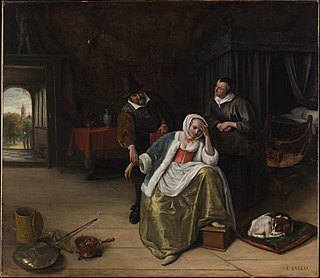
The Lovesick Maiden is a c. 1660 oil-on-canvas genre painting by Jan Steen. It shows a young woman suffering from love-sickness surrounded by her doctor and a maid-servant. It is in the collection of the Metropolitan Museum of Art.

Mental illness in ancient Rome was recognized in law as an issue of mental competence, and was diagnosed and treated in terms of ancient medical knowledge and philosophy, primarily Greek in origin, while at the same time popularly thought to have been caused by divine punishment, demonic spirits, or curses. Physicians and medical writers of the Roman world observed patients with conditions similar to anxiety disorders, mood disorders, dyslexia, schizophrenia, and speech disorders, among others, and assessed symptoms and risk factors for mood disorders as owing to alcohol abuse, aggression, and extreme emotions. It can be difficult to apply modern labels such as schizophrenia accurately to conditions described in ancient medical writings and other literature, which may for instance be referring instead to mania.
Modern historians' knowledge of ancient Roman gynecology and obstetrics primarily comes from Soranus of Ephesus' four-volume treatise on gynecology. His writings covered medical conditions such as uterine prolapse and cancer and treatments involving materials such as herbs and tools such as pessaries. Ancient Roman doctors believed that menstruation was designed to rid the female body of excess fluids. They believed that menstrual blood had special powers. Roman doctors may also have noticed conditions such as premenstrual syndrome.
References
- ↑ "web page template". academic.mu.edu. Retrieved 2019-12-31.
- 1 2 Merskey, Harold; Potter, Paul (1989). "The womb lay still in ancient Egypt". British Journal of Psychiatry. 154 (6): 751–753. doi:10.1192/bjp.154.6.751. PMID 2688786. S2CID 38228923.
- ↑ Fitzharris, Lindsey (2017-04-28). "The Wandering Womb: Female Hysteria through the Ages". Dr Lindsey Fitzharris. Retrieved 2019-12-31.
- ↑ Aretaeus, of Cappadocia; Adams, Francis (1856-01-01). Aretaiou Kappadokou Ta sozomena = The extant works of Aretaeus, the Cappadocian. London : Printed for the Sydenham Society.
- ↑ Gilman, Sander L. (1993). Hysteria Beyond Freud. University of California Press. p. 26. ISBN 0520080645.
- ↑ Gilman, Sander (1993). Hysteria Beyond Freud. University of California Press. pp. 17–25. ISBN 0520080645.
- ↑ Gilman, Sander (1993). Hysteria Beyond Freud. University of California Press. pp. 18–20. ISBN 0520080645.
- ↑ Dean-Jones, Lesley (1994). Women in the Classical World: Image and Text. New York and London: Oxford University Press. p. 199.
- ↑ Gilman, Sander (1993). Hysteria Beyond Freud. University of California Press. p. 41. ISBN 0520080645.
- ↑ Gilman, Sander (1993). Hysteria Beyond Freud. University of California Press. pp. 116–118. ISBN 0520080645.
- ↑ Gilman, Sander L. (1993). Hysteria Beyond Freud. University of California Press. p. 118. ISBN 9780520080645.